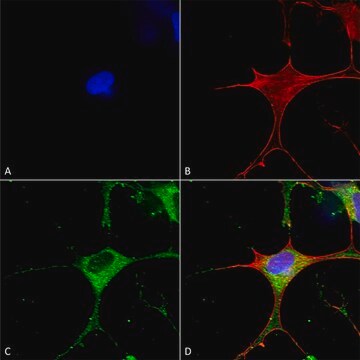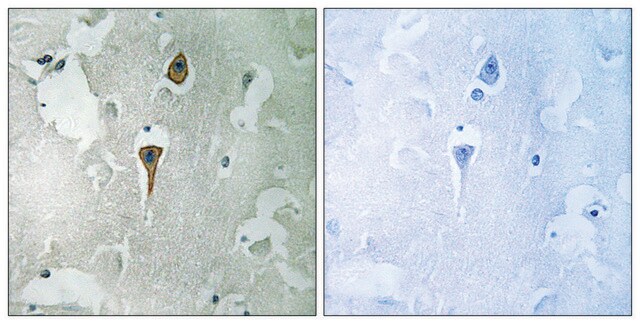05-432
Anti-NR1 Antibody, CT
Upstate®, from mouse
Sinônimo(s):
Grin1, NMDA R1 receptor C1 cassette, glutamate receptor, ionotropic, N-methyl D-aspartate 1
About This Item
Produtos recomendados
fonte biológica
mouse
Nível de qualidade
forma do anticorpo
purified immunoglobulin
tipo de produto de anticorpo
primary antibodies
clone
monoclonal
reatividade de espécies
rat
reatividade da espécie (prevista por homologia)
human, mouse
fabricante/nome comercial
Upstate®
técnica(s)
immunocytochemistry: suitable
immunoprecipitation (IP): suitable
western blot: suitable
Isotipo
IgG
nº de adesão NCBI
nº de adesão UniProt
Condições de expedição
wet ice
modificação pós-traducional do alvo
unmodified
Informações sobre genes
human ... GRIN1(2902)
rat ... Grin1(24408)
Descrição geral
Especificidade
Imunogênio
Aplicação
4 μg of a previous lot immunoprecipitated NR1 from 500mg of rat brain microsomal protein preparation.
Immunocytochemistry:
An independent laboratory has shown positive staining in QT-6 cells, transfected to express NR1, which were fixed with 4% paraformaldehyde/4% sucrose in PBS and in nontransfected cultured rat neurons.
Note: Do not boil the microsomal preparation. Incubate at room temperature for 30-45 minutes.
Qualidade
Western Blot Analysis:
0.5-2 μg/mL of this lot detected NR1 from 20 μg of rat brain microsomal protein preparation (Catalog # 12-144).
Descrição-alvo
forma física
Armazenamento e estabilidade
Outras notas
Informações legais
Not finding the right product?
Try our Ferramenta de seleção de produtos.
Código de classe de armazenamento
10 - Combustible liquids
Classe de risco de água (WGK)
WGK 1
Certificados de análise (COA)
Busque Certificados de análise (COA) digitando o Número do Lote do produto. Os números de lote e remessa podem ser encontrados no rótulo de um produto após a palavra “Lot” ou “Batch”.
Já possui este produto?
Encontre a documentação dos produtos que você adquiriu recentemente na biblioteca de documentos.
Nossa equipe de cientistas tem experiência em todas as áreas de pesquisa, incluindo Life Sciences, ciência de materiais, síntese química, cromatografia, química analítica e muitas outras.
Entre em contato com a assistência técnica








